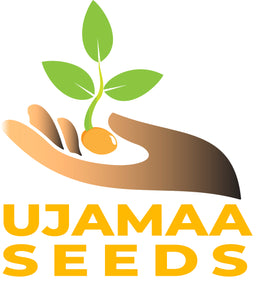Even Star Landrace Collards
Even Star Landrace, COLLARDS Brassica oleracea acephala
Seeds per pack ~ 70
Germination: 84% Oct 2024, Packed for 2025
Origins and History
The Even’ Star Landrace Collard is a unique heirloom developed through the patient and intentional selection work of organic farmer Brett Grohsgal of Even’ Star Organic Farm in southern Maryland. Over decades of cultivation, Grohsgal saved seed from collards that could withstand harsh mid-Atlantic winters, thrive in organic systems, and adapt to seasonal variability. As a result, this landrace collard is not a fixed uniform variety but rather a resilient population bred for diversity, cold-hardiness, and productivity. It reflects a long history of collards in African American foodways and Southern agriculture, carrying forward a tradition of adaptation and resilience in the face of changing climates.
Appearance and Characteristics
Even’ Star Landrace Collards feature robust, large leaves with a deep green coloration and broad, slightly puckered surfaces. Plants are vigorous and vary in leaf size, shape, and hue due to their landrace nature, offering a genetic richness that strengthens resilience. They are especially noted for their ability to survive repeated frosts, with leaves becoming sweeter after exposure to cold. Mature plants grow in an open rosette form, often reaching 2 to 3 feet in height, with thick stems that support continued leaf production throughout the season.
Culinary Uses
The flavor of Even’ Star Landrace Collards is rich, hearty, and mildly sweet—especially after frost exposure. The leaves are tender enough for quick sautéing when harvested young, but also hold up well in long-simmered traditional dishes such as collard greens with smoked meats or vegetarian broths. They are excellent for braising, stir-frying, steaming, or even using as a wrap in place of tortillas. Their adaptability makes them a favorite in kitchens that value both heritage Southern cuisine and innovative modern cooking.
Growing Tips
Even’ Star Landrace Collards are especially well-suited to USDA zones 6–9, thriving in cooler weather but adaptable to a wide range of conditions. Sow seeds directly outdoors in spring or late summer for fall and winter harvests. For best results, plant seeds at a depth of ¼ to ½ inch in fertile, well-drained soil enriched with organic matter. Thin seedlings to 12–18 inches apart to allow ample space for leafy growth. These collards are cold-hardy and can overwinter in many regions, making them a reliable green when most other vegetables have succumbed to frost.
Harvesting Guidance
Harvesting can begin when leaves reach a usable size, typically within 55–70 days from sowing. Younger leaves are tender and ideal for fresh cooking, while larger mature leaves are best for stewing or braising. Regularly pick the outer leaves, allowing the inner rosette to continue producing throughout the season. In milder climates or under protection, plants can be harvested steadily all winter, with flavor intensifying after each frost. To save seed, allow plants to bolt in their second season, ensuring a diverse mix that carries forward the landrace’s adaptability.



